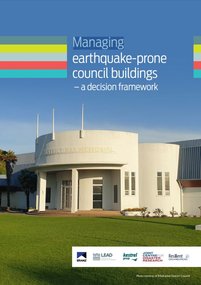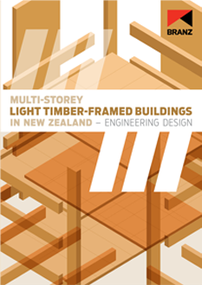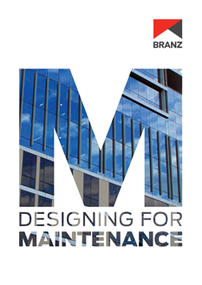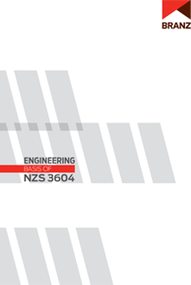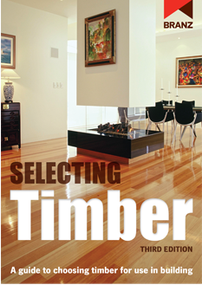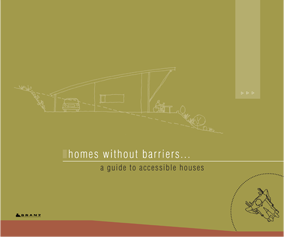Plumbing and Drainage Guide 3rd edition (PDF)
This guide explains the general principles of the plumbing codes and standards for sanitary plumbing in New Zealand and Australia. Issues such as backflow prevention, protection from scalding and explosion by hot water installations and the use of air admittance valves are explained in clear and simple text. This edition was updated and released in April 2024 to reflect recent changes to AS/NZ3500 series and amendments to New Zealand Building Code clauses G12 and G13.
Managing earthquake-prone council buildings – a decision framework
Using this guide This framework is intended for the management of council-owned buildings only. It is not intended to guide a council’s regulatory responsibilities for managing all earthquake-prone buildings in their area in general.
Multi-storey light timber-framed buildings in New Zealand: Engineering design
These guidelines describe methods for designing LTF structures that go beyond 2.5 storeys and are outside the scope of NZS 3604:2011 Timber-framed buildings. They provide guidance on how designers can develop resilient Code-compliant designs for light timber-framed structures up to 6 storeys. The focus is on structural solutions, but also included are discussions and suggestions for how to address a variety of other necessary design aspects of multi-unit residential buildings such as fire and acoustic performance, floor vibrations and weathertightness.
In conjunction with other timber building resources, these guidelines will allow designers to provide a range of low-carbon timber building options that meet the needs of the growing population and shifting community profiles throughout the country.
Note: You will need to register to download the guide so we can notify you of any technical updates to the guide.
Designing for maintenance
Buildings are complicated. As part of the design process, the building designer must balance a range of potentially conflicting considerations such as:
- client (owner/developer) attitudes to costs and maintenance
- material and finish costs
- material and finish performance
- equipment cost and performance
- environmental conditions, both internal and external
- maintenance requirements and associated costs for the materials/components selected
- complexity of design and detailing
- aesthetics
- access
- the expected refurbishment cycles for the building
- building use and potential changes in use during its life
- potential changes in available technology
- safety.
Design and construction quality can also have a significant impact on the life expectancy of a building's materials and components as well as on the maintenance and renewal requirements.
The aim of this book is to outline maintenance issues that should be considered as part of the design process so that completed buildings are able to be effectively and economically maintained.
Engineering basis of NZS 3604
This book is intended as a source document for those who need to know the basis for the engineering decisions underpinning NZS 3604 Timber-framed buildings.
NZS 3604 sets out the construction requirements for light timber-framed buildings in New Zealand that do not require specific structural engineering design. By limiting the size of the building and scope of application, a series of solutions are presented, enabling a designer to select an element or detail appropriate to the situation without needing to engage a structural engineer.
Selecting timber (3rd edition)
This is a guide for specifying and choosing timber for use in New Zealand buildings, which will be useful to all architects and designers, specifiers and builders working with timber.
As well as covering such key issues as timber treatment and moisture levels, the book features an extensive species data index, with separate sheets for each of 89 species of timber available on the New Zealand market. The data sheets cover key characteristics of each species such as timber strength, hardness and durability, borer susceptibility and typical uses.
Selecting timber briefly covers engineered wood products, plywoods and veneers, looking at their general characteristics, but does not cover specific performance or selection data for these.
House building guide (3rd edition)
This publication is a comprehensive, practical, step-by-step guide and is the ideal reference tool for anyone involved in house building. The easy-to-read format follows through all the key steps involved in house construction right from setting out the site to lining out.
This guide contains practical guidelines for good timber-framed house building, with hundreds of diagrams, easy to follow tables for quick reference and bullet points for easy reading. Informative illustrations show how all the elements fit together.
Plumbing and Drainage Guide 2nd edition
This guide explains the general principles of the plumbing codes and standards for sanitary plumbing in New Zealand and Australia. Issues such as backflow prevention, protection from scalding and explosion by hot water installations and the use of air admittance valves are explained in clear and simple text.
Please note: This publication is under review and we expect the third edition to be released in early 2024. The update will be aligned to published amendments to New Zealand Building Code G12/G13.
Homes without barriers: A guide to accessible houses
For most of us, the word 'home' means a place of comfort, a refuge, a place where we can be ourselves and relax. For people with disabilities or those growing older, home has a special importance because they are likely to spend more time there. But when physical barriers and poor design make that home difficult to live in, health, safety and happiness can be compromised.
Designing and adapting houses in a way that enables people to really live in their own home for longer makes sound economic as well as emotional sense. It will lessen dependency, lower the risk of accidents, reduce the cost to society and possibly even increase the resale value.
This guide is about houses that are not disabling. It was developed in conjunction with many people working in the health and disability fields. It is packed with diagrams and advice for building designers, builders, health professionals, homeowners and anyone involved in the design or alteration of houses for those with disabilities or the elderly.

